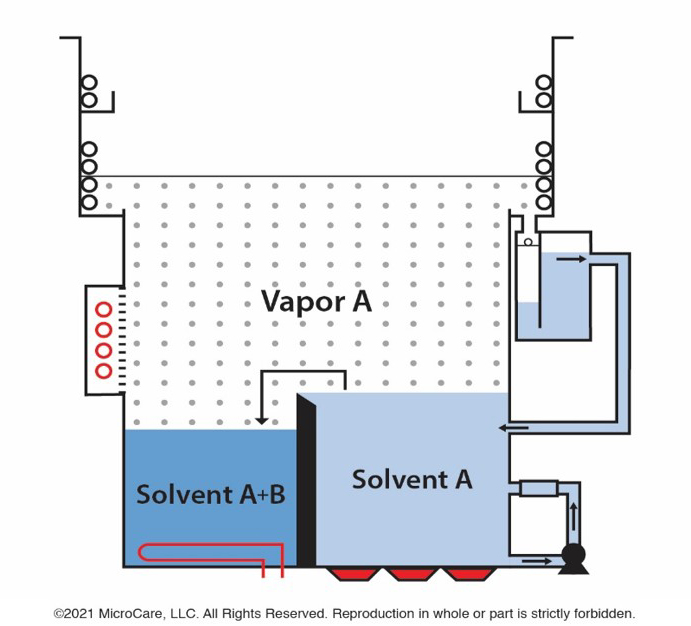How Easy is It to Convert to a Co-Solvent Cleaning Process?
Co-solvent cleaning in a vapor degreaser delivers the convenience and speed of traditional mono-solvent cleaning, but intensifies this cleaning with a second cleaning fluid. The two co-solvents have very distinct behaviors. One boils at low temperature and the other boils at a very high temperature, working together to enhance overall cleaning performance.This second high boiling point, non-volatile solvating agent provides the additional cleaning horsepower.
The high-temperature, non-volatile solvating agent (Solvent B) dissolves stubborn, difficult soils including solder fluxes, silicone oils, synthetic greases, grinding media and inks.
The low-boiling, non-volatile rinsing agent (Solvent A) then washes the solvating agent off of the components and creates a vapor blanket for more cleaning and drying.
Most fabricators turn to co-solvent cleaning inside their vapor degreasers if they are having trouble getting parts clean using a mono-solvent cleaning process. Common problems include:
- Poor cleaning results
- Compatibility issues with either the substrate or the contaminant or soil
- Toxicity concerns of the current cleaner
- Regulatory changes or scrutiny of the existing cleaner
Few Equipment Changes Needed
In many instances, an existing vapor degreaser that is properly designed and in good condition can accommodate the co-solvent cleaning process. In some cases, simple modifications may be necessary depending on present heating and cooling capacities as well as cleanliness requirements. These include things like resetting temperature controls or adding a still to improve heating and cooling capacity. No additional venting is needed.
No Maintenance Required
The co-solvents inside the vapor degreaser require little monitoring and do not need acid acceptance testing or boosters, unlike legacy solvents including nPB. The vapor degreaser uses and recycles the co-solvents for hundreds of hours before they need to be replaced. The vapor degreasing system concentrates the soils which are periodically removed and disposed, saving on hazardous waste costs.
Other Costs and Savings
Co-solvent cleaning is typically more expensive than mono-solvent cleaning due to the secondary cleaning agent. However, co-solvent cleaning does reduce the time and labor costs trying to unsuccessfully re-clean dirty parts.
Easy Operations
In most instances, operating parameters are similar to mono-solvent cleaning processes. The cleaning cycle could be slightly longer. The specifics can easily be determined through a cleaning trial conducted inside the MicroCare Critical Cleaning Lab. Send us your soiled parts and we can determine which cleaning solvent(s) and methods are right for you.

